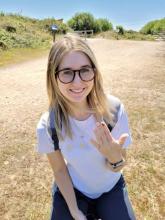Professional summary
Abigail is an interdisciplinary ecologist within the Biological Records Centre at UKCEH. Her research uses citizen science to understand the interaction of people, nature, and environmental data through biodiversity monitoring and public engagement.
Abigail's work focuses on the use of co-design in the development of citizen science projects, ensuring that studies are designed with input from the participants involved. This year, Abigail has been working with farmers to co-develop a moth monitoring programme and explore how an AI-based identification tool can enhance oportunities for farmer-led citizen science. The project has seen 24 farmers in England using LED battery-powered moth traps to monitor moths on their farm once a week and use the e-Surveyor app to record their findings. Farmers' attitudes toward the monitoring, along with in-depth feedback will be gathered through questionnaires. The aim is to understand how participation in monitoring can influence perceptions and behaviours, and support agri-environmental managament.
Over the next few years, Abigail will contribute to several projects. TRANSFORM, a five-year project, will involve working with farmers across Europe to develop climate-resilient crop rotations. She is also involved in the National Education Nature Park, a project encouraging young people across England to get involved in biodiversity monitoring and improvement to transform the education estate. Another innovative project will use an origami-based paper sensor to detect eDNA of freshwater invasive species.
Abigail completed her PhD at the National Botanic Garden of Wales and Bangor University where she used DNA metabarcoding to identify the plants visited by pollinators. In her previous role at the Natural History Museum, she co-ordinated a national community science programme, Nature Overheard, which was co-developed with young people.
Lowe A., Jones L., Witter L., Creer S., de Vere N. (2022). Using DNA Metabarcoding to Identify Floral Visitation by Pollinators. Diversity 14:236.
Lowe A., Jones L., Brennan G., Creer S., Christie L. de Vere N., (2022) Temporal change in floral availability leads to periods of resource limitation and affects diet specificity in a generalist pollinator Molecular Ecology.
Lowe A, Jones L, Brennan G, Creer S., de Vere N. (2022). Seasonal progression and differences in major floral resource use by bees and hoverflies in a diverse horticultural and agricultural landscape revealed by DNA metabarcoding. Journal of Applied Ecology.
Jones L., Lowe A., Ford C.R., Christie L., Creer S., de Vere N., (2022). Temporal Patterns of Honeybee Foraging in a Diverse Floral Landscape Revealed Using Pollen DNA Metabarcoding of Honey, Integrative and Comparative Biology.
Jones, L., Brennan, G.L., Lowe, A., Creer, S., Ford, C.R., de Vere, N., (2021). Shifts in honeybee foraging reveal historical changes in floral resources. Communications Biology. 4, 37.
de Vere N, Jones LE, Gilmore T, Moscrop J, Lowe A, Smith D, Hegarty M, Creer S, Ford CR (2017) Using DNA metabarcoding to investigate honey bee foraging reveals limited flower use despite high floral availability. Scientific Reports 7, 42838.
